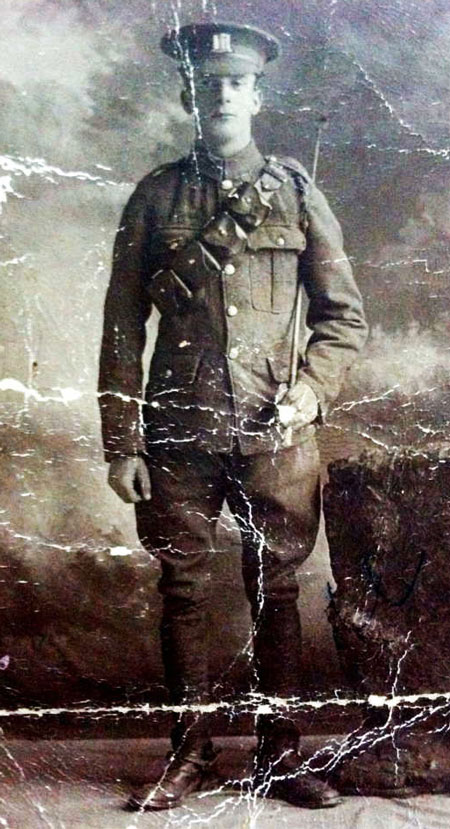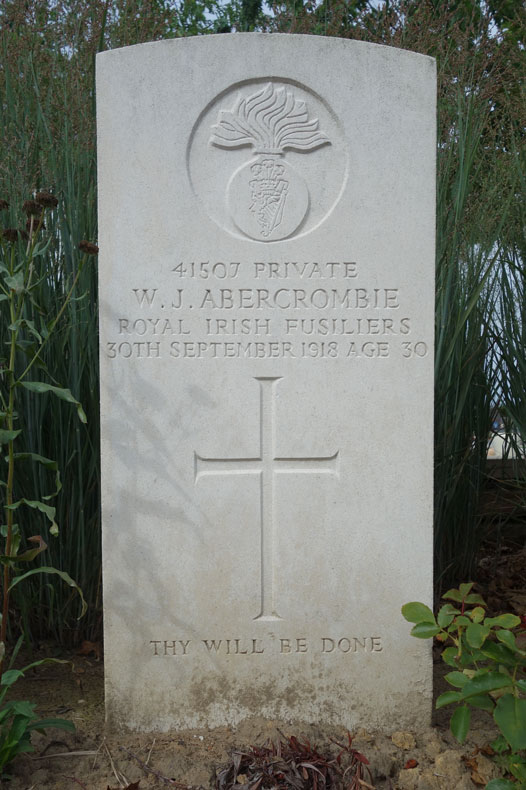![]() In memoriam
In memoriam ![]()
Private William James Abercrombie

William James Abercrombie was born on 28 February 1893 at Bohevny, Florencecourt, County Fermanagh, the first of four children of farmer Hugh Abercrombie and his wife Emily Evangelina (née Frazer). His father died when William was was just five and his mother remarried soon after, to a James Brownlee. At the time of the 1901 Census he was living at Blacklion, County Cavan, with his mother, maternal grandmother,a sister and other relatives. Ten years later he was living at Bohevny and working on the farm of Andrew Stafford.
Abercrombie enlisted in the 6th (Inniskilling) Dragoons Service Squadron at Enniskillen between 14 and 25 August 1915 (No. UD/279). On 6 October the squadron, which was then serving as divisional cavalry to the 36th (Ulster) Division, embarked for France. Abercrombie, however, remained at the reinforcements depot at Enniskillen until 1916 or the first half of 1917 when he embarked for France as a reinforcement for the squadron.
In June 1916 the Inniskillings squadron had joined with C and F Squadrons of the North Irish Horse to form the 2nd North Irish Horse Regiment, serving as corps cavalry to X Corps until August the following year. In September 1917 the 2nd Regiment was disbanded and most of its officers and men were transferred to the 9th (Service) Battalion, Royal Irish Fusiliers – which was renamed the 9th (North Irish Horse) Battalion. Abercrombie, like the majority of the men, was transferred to the battalion on 20 September. He was issued a new regimental number – 41507 – and posted to B Company
In November and December 1917 the 9th (NIH) Battalion was in action in the Battle of Cambrai. Abercrombie was severely wounded in the left forearm during the attack on the village of Moeuvres on 22 and 23 November. The battalion war diary for those days reads as follows:
[22 November] The Battn moved up at 6.30 a.m. to a position N. of Bapaume & Cambrai Road arriving at 8.30 a.m. Here the Battn waited for an order to attack Inchi when Moeuvres was taken by the 12th Royal Irish Rifles. At 11.45 a.m. the 12th R. Ir. Rifles captured village of Moeuvres. It was unable to clear trenches East of village. At 5.30 p.m. Battn moved up to support 12th R. Ir. Rifles in the village of Moeuvres. At 5.45 p.m. 12th R. Ir. Rifles reported driven out of village. At 8.30 p.m. Battn less 'D' Coy counter attacked village of Moeuvres but was driven back to trenches immediately south of the village, where it took up a defensive position for the night.
[23 November] Battn attacked Moeuvres at 10.30 a.m. At 11 a.m. Battn reported in village. At 11.45 a.m. enemy counter attacked from trenches West of village. 12.15 p.m. counter attack driven off. At 4.30 .p.m village evacuated by Battn on account of supports not coming up. 5 p.m. 'C' & 'D' Coys took up position on Sunken Road South of village and 'A' & 'B' Coys went back to trenches North of Bapaume & Cambrai Road.
Casualties for 22nd & 23rd: Officers killed 1. Officers wounded 6. ORs 82 casualties.
Abercrombie was evacuated via the 29th Casualty Clearing Station to the No.18 General Hospital. He may then have been shipped to the UK for treatment. Following his recovery he rejoined his unit during 1918.
On 30 September 1918 the 9th (NIH) Battalion was ordered to advance on the Belgian village of Vijfwegen. The fighting centred on a small rise, Hill 41, which had been well fortified by the Germans and afforded a wide field of fire on troops attempting to move past it. During this and the following day they sustained numerous casualties – eight officers and 139 other ranks, including 29 killed in action and seven more who would die of their wounds.
Private Abercrombie was one of the men killed at this time, either on 30 September or 1 October. He was buried with a number of other casualties on the battlefield next to the Terhand-Vijfwegen road, just east of Methven Wood (map reference 28.K.23.a.6.8), the site marked with a cross. After the war his body was exhumed and reburied in the Dadizeele New British Cemetery, Moorslede, West-Vlaanderen, Belgium, grave IV.F.24. His gravestone inscription reads:
41507 PRIVATE
W. J. ABERCROMBIE
ROYAL IRISH FUSILIERS
30TH SEPTEMBER 1918 AGE 30
THY WILL BE DONE
Note: Commonwealth War Graves Commission records state Abercrombie's age as 30 at the time of his death, but he was actually 25. This suggests he may have overstated his age when he enlisted.

Image of Private Abercrombie sourced from Ancestry.com Public Member Trees, contributor 'MichelleABurke'. Gravestone images Copyright © Phillip Tardif with all rights reserved as set out in this Use of Material policy.
This page last updated 6 July 2023.

